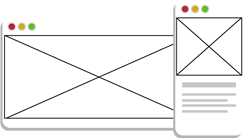It all started when I was hired to redesign a website that was a combination of articles, products, and ‘really engaging’ visual content. Then I discovered, the admin area of the website, that is, the part that controls the content management for the front-facing part of the website, that I discovered a growing problem for business website owners that stress over managing their content on their own websites.
For the most part, when you’re going to make changes to your website, they usually involve one or more areas of detail. Imagery, text, navigation, and advertising are just a few of the many areas that a full fledged website needs to reach its full potential. But you are never doing all of the things at once, in fact, you probably are doing them in phases. Organizing the categories a few times a month, writing articles a few times a week, or updating product descriptions once a season — hardly are you ever making changes to every part of a website at the same time and that’s what I realized causes fatigue with business owners when managing their website.
If you’re a writer, does it matter to you to see the settings for a Google Captcha? Or say if you’re a shop manager, does it matter to see the contact form settings of your website when all you wanted to do was update the site with the latest products. I’ve experienced that unless you’re a tech-saavy person, seeing all of these options at the same time can create decision fatigue.
Too many boring links, not enough emotional assistance.
The reason this problem came to grow into what it is now is because when you first start off with a website, you begin with a few features that are useful to publish your message in various pages, posts, and sidebars throughout the website, but as the web development becomes more advanced, so do the tools needed to get the job done.
Social media share buttons, newsletter signup forms, contact support forms, product pages, image galleries, and tons of enhancements like image compression and user security are just a sample of the features that might be added to a website to really take advantage of the modern technology available today. Though they are useful tools, they are usually organized in a poor manner. Plugin developers are limited to the hierarchy of which order to display their ‘nifty’ feature on your admin dashboard, but since the goal of most developers is to increase engagement with their software, it usually ends up having plugins fight for the top spot on your admin dashboard.
Case in point: Product Descriptions
If you were to look at my admin dashboard right now, you’d see that the link to edit product descriptions is 15 links down from the very first link in my admin dashboard menu. By the time you read through each of the links, and end up having disturbed your ‘train of thought’ when you were going to just write some descriptions for your products.
- Dashboard
- Posts
- Sliders *
- Media
- Gallery *
- Pages
- Comments
- Affiliates *
- Ads *
- Social Media Share Buttons *
- Contact Forms *
- Memberships *
- Newsletters *
- SEO *
- Products *
* 10 additional plugin features that are not installed by default
And that is just half of all the links on my admin dashboard so I can see why people have decision fatigue when updating websites, there are too many links and too many decisions to make.
So with that being said, I’ve decided to solve this problem for my clients by creating a system that allows them to re-organize their admin area to their liking. Which in turn can increase productivity and also ensure that only the most essential links are easy to access.
Case Study — Bonoboville Social Media
Now that I have narrowed down that decision fatigue is a real thing for website owners, I decided to put this concept to the test. For the client, some of the settings are not necessary on a day to day basis, but more reserved for software developers that can better understand the advanced features capabilities. Captchas, avatars, and social media buttons are just a few of the many features that don’t necessarily need attention every time you need to make a public statement on your website. In fact, there are many departments that update the website and they each require special assistance when making those changes.
Here’s a few of the departments needed for a growing social media website.
- Writing Department
- Community Support Department
- Store Management
- Analytics & Advertising
As you can see, each of these departments are unique to their own specific goals. Writing departments want to write articles and pages. Community support departments want to communicate with humans. Store managers want to curate a product lineup that suits their customers needs. Analytics & advertising departments want to know which types of content is driving more engagement than others. I know I’m missing other departments but when you’re in charge of a growing community, you tend to wear many hats in the development of the website.
Last Updated: March 3, 2023(Share)









